Golf & Goblins Free-To-Play Mobile Re-Design
Golf & Goblins was developed in 2 weeks for PC as a game jam entry, as well as to increase shareability. However, mobile was always the intended platform for any future development due to the suitability of touch controls paired with the market accessibility. This will be a study into how the game would be converted to a free-to-play (F2P) monetisation model for release on mobile devices.
I had not focused on this matter during development, so this is more of a thought experiment than a set plan of action. I have conducted research on the subject matter, but am likely missing some valuable data that would've heavily influenced my proposal. I will be looking to deliver a design-focused approach that I believe would be appropriate and successful.
I will briefly outline the advantages of F2P over a paid release to determine the best choice for Golf & Goblins. I'll evaluate the main F2P pricing strategies and models available and assess the strengths and weaknesses of each. It's important to consider that different strategies will be better suited to specific games and genres. Finally, my proposed strategy will be outlined following the enclosed discussion.
Monetisation models: Paid vs. Free
I'll begin by evaluating the main considerations when deciding between releasing a F2P and a paid title. As developers have steadily increased their knowledge of monetisation techniques and how best to utilise them, F2P has risen to an overwhelming dominance on mobile, both in terms of success and popularity.
A free game will drive a far larger install base which is important to gain traction in the immensely crowded market. F2P games have become ubiquitous and the industry standard with greater maximum revenue potential; they account for the vast majority of the highest grossing titles on app stores worldwide. (1)
Paid titles can become buried under the daily deluge of free offerings so struggle to compete for mindshare; they have become the exception. I see the premium model being best used for games that would require significant gameplay alterations to work around a given F2P model, resulting in a negative impact upon the game. This includes more pure and unique experiences, commonly adventure games or more artistically natured games like Monument Valley. (2) Another example would be mobile re-releases or ports such as Final Fantasy VII. Sales will benefit from the trust consumers have in an established title from a recognised brand like Square Enix.
Providing new content to a paid game can also be a predicament, especially for level-based games like Golf & Goblins. Extensive content bundles such as level packs would have an additional cost, but could potentially be far less popular than the main game purchase. This would be a risk in terms of development resources. If the content is smaller and more frequent, then the levels could be provided for free. This approach would predominantly be to drive new sales as existing consumers have already paid the upfront cost. In this respect, F2P has the advantage as adding additional content always has a purpose. Regularly updated content helps keep hold of existing players as potential consumers.
Michael Katkoff, former SVP of Games at Rovio, along with his team converted Angry Birds from a paid game to F2P with Angry Birds Rio. He outlines the main ways they set out to "improve retention, engagement and monetisation without hurting the ratings/fans". (3):
- Increase the replayability of each level by incorporating a mastery system i.e. achieving 3-stars on sets of levels to unlock Star levels.
- Booster packs including power-ups and items added as a monetisation mechanic.
- Daily bonuses to drive retention and increase booster familiarity and use through these giveaways.
Combined approach
"Everything depends on the game in question. Not all premium games make good free-to-play games, not all free-to-play games make good premium games." Jeppe Bisbjerg, Kiloo (Subways Surfers) (4)
One option would be to provide both a paid ad-free version to supplement a free ad-supported one. Benefits of this approach would include allowing the game to stay as near to the original intended vision as possible, as well as giving more options to pay for the game. On the other hand, it might create a fragmented and unfocused marketing message. It could impact the monetisation potential of the free title, which would have to be predominantly funded by ads to keep development consistent between download types.
Both the free and paid version could still incorporate cosmetics at set costs. However, having a split economy with both real money purchases and in-game currency would be complicated so I would look to avoid this set-up.
Final verdict: Monetisation model
Golf & Goblins will be F2P only. This approach will give it the best chance to gain a following and help deliver a focused marketing message with one standard download. It will also allow the game to be built from the ground up around this business model for a more tailored environment. This will allow for a combination of techniques to be implemented, giving more opportunity for players to indulge. It will give the game the best chance to succeed in today's fierce mobile space.
Currency: Coins
Coins have an obvious function and help reinforce the game's hybrid platforming nature, ergo they're the perfect currency of choice. I would stick to one single currency over a split coins/gems system for simplicity's sake. Coin packs will be purchasable from the in-game store. The ways in which coins are rewarded and can be spent will be discussed within the following sections.
Angry Birds uses Gems as a premium hard currency over direct purchases for 4 reasons (3):
- Increases retention as players feel the need to make use of their stored up currency.
- Increases the size of an average purchase due to limited buy-in price options.
- Enables effective use of incentivised video ads.
- Encourages players into buying currency while they can, before they may need it e.g. before a long journey.
Power-ups
Golf & Goblins isn't a typical golf game so power-ups are more of a complicated issue. Golf games have pauses between shots, whereas Golf & Goblins will sometimes involve several shots in quick succession. With the physics environment along with the added factor of enemies, the gameplay will be more fast-paced. Therefore, I am slightly apprehensive about implementing a system where players can select between multiple power-ups from a drop-down menu during gameplay.
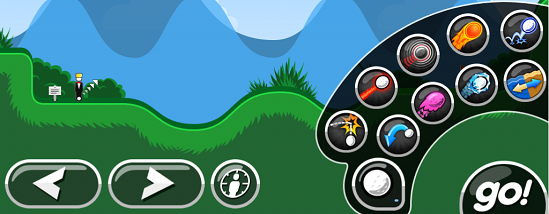
Traditional platformers often favour having set power-ups situated in specific locations to be collected within the level, which doesn't always lend itself very well to a F2P model.
My inclination is that a simplified system would be more appropriate, with players selecting one power-up to use before, or at the start of each hole. These power-ups would come in two varieties, passive modifiers and activated abilities:
Passive modifiers would be permanent throughout the entire level, +10% power, +10% bounciness etc. Activated power-ups would trigger via a button in the bottom right of the screen. Examples include a short in-air double jump that doesn't cost a shot and a parachute which increases drag to slow down the ball for more accurate landings.
Power-up system concerns
One concern would be whether the necessity to deliver a significant range of power-ups that involve a gradual undertaking to acquire, would detract from the core intended vision of being a simple, accessible game. On the contrary, the gradual unlock process would contribute to a beneficial slow ramp in complexity, giving players more time to learn each item.
My other concern would be in terms of the balancing. With a substantial item pool, making sure each item is well balanced will be challenging and would require extensive testing along with potential future balance patches. Similarly, I wouldn't want the system to be pay-to-win. I would strive to ensure that the game was fair and practically all levels were possible without the use of special abilities. One way to help with this would be to have a default power-up, perhaps that would be an aftertouch ability used in the air to apply backspin or topspin upon ground contact. The intention would be for unlockables to be more sidegrades with situational advantages instead of strict upgrades.
Final verdict: Power-ups
It's difficult to make a definitive decision on power-ups as they are yet to be designed and tested. Therefore, this proposition is mostly conjecture revolving around the design implications of potential power-up systems within a F2P model.
Overall, I believe the benefits outweigh my trepidation. Power-ups would help to create a more diverse, exciting game. They would add depth to the gameplay and open up design space for more complex levels designed to facilitate their creative use. It would increase replayability, which is an essential trait to have for a F2P game to maintain a healthy long-term revenue stream.
Mulligan
A mulligan originates from golf as the ability to retake a shot. This ability would be usable once per hole and would cost a small amount of coins. It would be an important tool in creating a valuable coin economy, as a gold sink and impulse purchase for players.
Alongside the monetary aspect, it's also a fun mechanic. Players always have that feeling that if they just had a second chance at a shot they'd succeed and it gives players that desirable power. The single use limit makes the timing for when to use it an interesting decision.
Finding the perfect implementation would need careful consideration. Perhaps it would be overpowered in Tournament mode (18 consecutive holes) and affect the credibility of leaderboard scores. In that case, the leaderboards could only accept non-mulligan scores in the extreme, whilst implementing a maximum of between 5-10 for an 18-hole tournament round would probably be superior.
Energy system
Energy systems that utilise stamina or lives are very divisive and even despised by many consumers, yet they have become increasingly popular in recent years. They have proved to be an extremely efficient F2P model.
"designers use energy systems to pace their content and to ensure that players consume content at roughly the same rate. Once players have run out of new content to experience, they usually have little interest in a game. It is vital therefore, to ensure that players are not consuming content faster than you can produce it." Ed Biden (5)
F2P games are generally designed to be impossible, or at least incredibly difficult to fully complete. Energy systems are very effective at controlling the pace at which content is consumed and make playing the game more habitual. As a game design tool, they function as another resource for players to manage. Energy systems are often used to supplement other monetisation methods as they're generally more focused on player retention.
Angry Birds switched to using an energy-based lives system with Angry Birds 2, (6) where in the past Rovio were against this sort of restriction. (7) (8)
"We weren’t allowed to use lives-mechanic. It was considered as a too punishing of a game mechanic. Rovio was, and still is, a fan driven company that will put the interest of their customers ahead of the short term business interest." Michael Katkoff (3)
Final verdict: Energy system
In summary, I would favour an alternative to an energy system for Golf & Goblins, although I am open to being persuaded with empirical evidence towards its suitability and effectiveness. I think stopping players partway through an 18-hole course for example would lead to negative experiences. That isn't an important point that players would be excited to resume from the next day. The stamina system specifically seems best suited to resource management games, where players are eager to play again soon to discover how their crops or city has developed in that time.
For Golf & Goblins, a game with finite levels, an energy-based lives system would help prolong game completion time and incentivise daily play. One option would be to incorporate a lives system into a specific mode; I explore that idea later with Tournament mode.
Player engagement
Customer retention is vital to the success of F2P games. (9) To increase player engagement, Golf & Goblins will look to maximise content to prolong game completion.
The main strategy to achieving this general philosophy and design intent will be implementing various game modes, which is verging more towards being concerned with design than business model. Nonetheless, I think it's important to consider the ways in which the game will be played, as the game's scores, items such as cosmetics and ultimately the entire currency hold little value if the game doesn't have sufficient content to use them in.
Multiple radically different modes wouldn't be suitable for the game's intentionally simple approach or realistic in terms of development resources. The succinct overall goal will be to make a lot out of a little. In practice, this approach will involve techniques such as modes with slightly different rules, as well as packing as much as possible into each level to increase their replayability.
This is especially important as the game will only have a finite number of levels. Procedurally generated levels wouldn't be ideal, as they would require a large amount of initial development resources and could result in levels being bland, lacklustre and poorly balanced. I believe there are more suitable solutions to minimise the chance for players to reach the feeling that they have ever completed the game.
The general strategy to achieve that will be to give players as many things to do as possible. This will increase players' enjoyment and attention, which importantly increases their chance to want, spend and ultimately need (to buy) coins. This doesn't necessarily mean more modes or unique ways to play, it also includes the addition of goals and achievements within each level for players to continually strive for.
Another simple method will be to ensure that the game isn't too easy. The game should ramp up in difficulty and getting par on each hole should be obtainable for all, but there must be a reasonable level of difficulty especially for later levels. This will ensure the game cannot be completed too quickly and increase the value of mulligans and power-up abilities. Going further, if later levels require coins to be unlocked then there should be a point where players need to backtrack and improve a number of old course scores. It shouldn't be a completely smooth path through the game for the average player or the need for buying coins decreases.
Game modes
Play mode, level unlocks & additional content
In the standard Play mode, players play through all holes and can unlock later courses with a combination of coins and medals. The medal criteria will ensure the average player doesn't unlock all courses without ever backtracking to better their scores. Certain holes will include hidden alternative holes to unlock secret levels, giving players even more reason to explore each level rigorously to see what they can discover.
New level packs and courses would be added to the game to be unlocked with coins. Fresh content will keep active players playing, as well as bring back players who may have ran out of levels to play to further increase the maximum playtime potential.
Level rewards
Each level will have medal criteria for coin rewards. The standard medal thresholds will be:
| Par | Standard completion | 0 coins + unlock next level |
| Birdie (-1) | Bronze medal | 1 coin |
| Eagle (-2) | Silver medal | 2 coins |
| X under par | Gold medal | 3 coins |
| Y under par + all coins collected | Platinum medal | 4 coins |
X & Y values will differ between holes to allow for better medal difficulty adjustment over using fixed universal amounts.
Coin challenge
Each hole will include 5 coin tokens scattered throughout the level. Players must collect all tokens and finish within par to receive a 5-coin reward. I chose this method over simple permanent coin collecting as it creates another goal to further increase level replayability. These challenges will be difficult and function as the game's equivalent to collecting the letters 'S-K-A-T-E'.
Tournament mode
In Tournament mode, players will need to complete all 18 holes of a course consecutively to receive a final score.
One option would be to make each tournament playable once per day. This would bring back players daily to have another crack at a successive 18-hole run with the essence and benefits of an energy system. The daily limit would also make the mode more tense and exciting. This finality leads to an increased importance for every run, which has the added benefit of increasing the likelihood that players will purchase tools like mulligans to help achieve top scores.
Overall, I like this approach as it focuses an energy-like system into a single mode more catered towards it than single one-off levels. My belief is that it would be one of the principal game modes. For players who want to play at their leisure, there will be multiple Tournament courses to play, as well as other more open game modes.
Daily challenges
Daily challenges would be a great way to encourage frequent, shorter plays sessions with temporary coin rewards, providing a continual open loop to nurture long term player engagement. (10)
Challenges will have certain criteria to complete and come in two varieties. The most common challenge type will be played on existing holes i.e. 'get an eagle' or 'get a hole-in-one', either from the starting pin or a specific spawn point on longer holes. On rare occasion, novel physics-based puzzles and set-ups will take place on custom or modified levels.
Challenge mode
Unique challenges (some may repeat) will be archived in the Challenge compendium. Players will be able to complete them at their leisure, but will not receive the coin rewards. Completing a set number of challenges will unlock cosmetic rewards to incentivise players to keep up-to-date, or catch up with a Challenge mode routine.
High scores & leaderboards
High scores and leaderboards are important as they give players goals to strive for and a reason to keep coming back to play again and again, even after practical game completion. High scores would be personal in-game records of holes, medals and tournament results, whilst leaderboards would include both global and friends' scores. These records will provide healthy competition and give players an incentive to continually pursue better scores, which increases the chance of them spending money in the game.
High scores and leaderboards can also increase the game's virality by increasing social media exposure. (11) Players are more likely to share their high scores than generic game screenshots; this feature will be offered after each hole, giving coins in return for the free marketing effect.
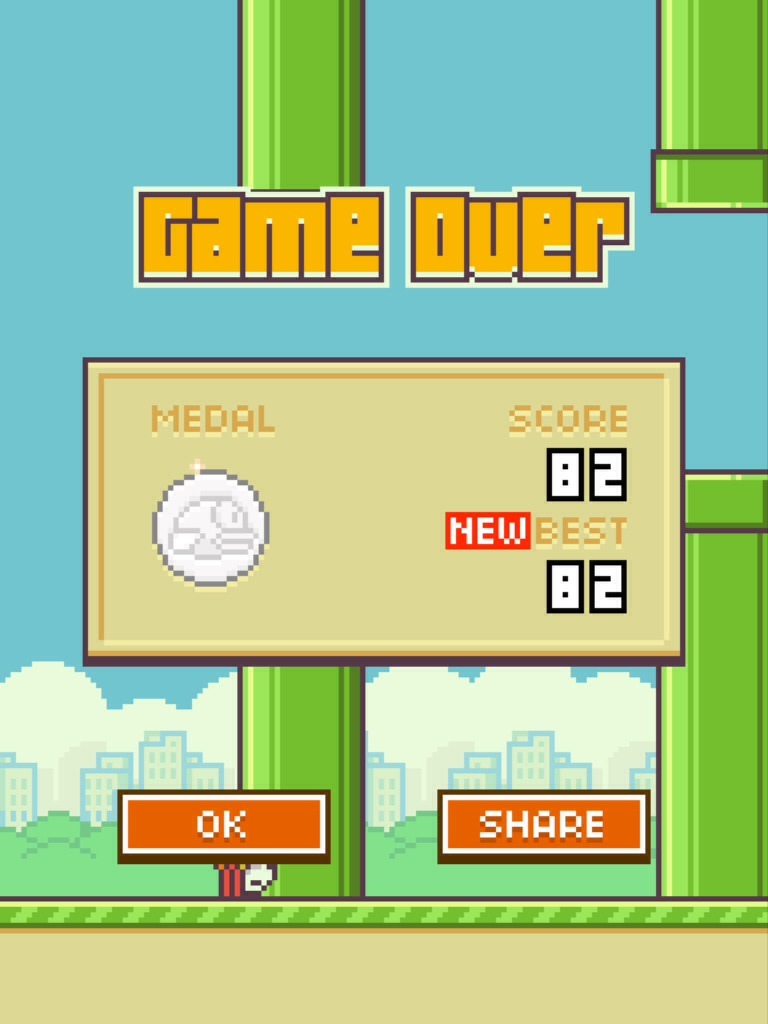
Clubhouse / menu
The Clubhouse will function as the game menu, the hub for modes and miscellaneous activities such as the store and social features. Its visual depiction will help create an interesting atmosphere, whilst players will hopefully enjoy navigating through the fitting setting within the world.
An Achievements section on the wall will display leaderboards and high scores. A trophy cabinet will offer a visual representation of the players' success on each course.
The clubhouse Phone would function as a friend list. If players recruit friends they will both receive a referral bonus to promote game discussion and long-term engagement. Friends' scores will be displayed on the leaderboards.
The clubhouse TV will offer opt-in video adverts. It could also include gameplay tutorials.
In-game advertising
In-game advertising will be the game's primary resource generator. One reason for this is an acknowledgement of the game's new status. My assumption is that advertisements would be a more reliable income source than in-game purchases for a game that would be somewhat of an unknown quantity within the market. The game is also designed to be minimal in function and aesthetic, incorporating ads allows for a more streamlined gameplay experience and a more controlled, supplementary approach for greater game-altering initiatives. Finally, video ads have grown in dominance and effectiveness in recent years. Alto's Adventure is a comparatively similar game that has had great success with opt-in video ads:
"The f2p version of Alto has resulted in a ton of downloads, but the main revenue driver is not IAPs (in-app purchases) but instead opt-in video. The IAPs account for less than 1% of all revenue on the platform, just reinforcing the fact that the average player would rather watch an ad than pay for anything." (12)
From my perspective, effective ads are contextually integrated into the overall experience. For Golf & Goblins, the most appropriate location for ads would be shown on the scoreboard at the end of the hole. This would include occasional video ads, supplemented by banner ads. The ad frequency would need to be determined, as I believe at the end of each hole would be excessive, especially with multiple monetisation methods employed. I would estimate at the end of each third hole would be sufficient, equating to 6 in an 18-hole course.
"Build engaging mobile advertising experience on mobile that is integrated natively, brings value to the customer, and is served with intent." Mobile Dev Memo (13)
The ads would be suitably positioned at a break in play, which would be less intrusive on actual gameplay, although still inevitable after a certain time. Players should still be attentive following directly on from gameplay, providing a reasonable click-through rate. I speculate that ads being shown when the player is on a high, in this case when completing a hole would also contribute to their success.
I would prefer to avoid small banner ads during gameplay. They would be detrimental to the game experience which at times will involve relatively fast-paced action. They also add aesthetically unappealing visual clutter, contrasting the game's minimal, clean feel.
If permanent on-screen ads are necessary for revenue reasons, I would want to restrict them to only show during aiming, whilst the ball is stationary. These moments are less hectic and wouldn't require fast actions and touch gestures. If they were shown when moving at speed they would be distracting and potentially very frustrating if accidentally clicked during gameplay.
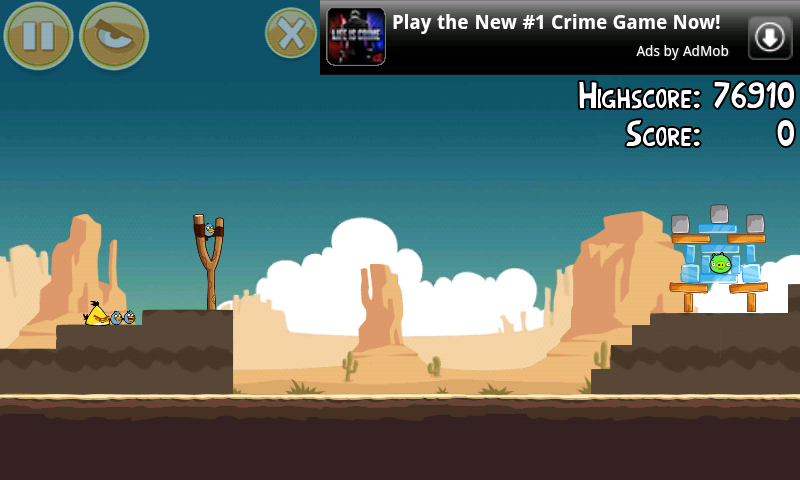
Opt-in adverts
The game will provide opt-in video ads at certain intervals, embedded within the scoreboard for bonus coin rewards. Another amusing, more convenient option will be for players to voluntarily watch video ads on the Clubhouse TV. There could be a number of short funny animations representing shows that would play between advertisements, which would attempt to make the experience worthwhile at least once for all players. It could be used to accrue coins if players deem it a fruitful endeavour.
Developers like Hyper Hippo benefitted from making ads core to the overall experience.
Mobile game, Adventure Capitalist integrates rewarded advertising by allowing players to watch up to five rewarded ads a day, providing a double-income boost for four hours. During a 2015 GDC presentation, the game’s producer Anthony Pecorella said that when Hyper Hippo launched this new feature, players were even reporting bugs with the rewarded ads because they wanted to take advantage of the offer. “There’s no better way to know that we did the ads well than to have people say, ‘Hey! We can’t watch your ads. Fix it.'” (14)
Cosmetics
I don't think cosmetics are a simple proposition for Golf & Goblins. I hold some reservations about incorporating them into the game, although I acknowledge their commercial potential. Cosmetics would be unlockable via the in-game store with coins. Loot boxes or a coin lottery could be used to unlock cosmetics although I am uncertain exactly how that would work at this stage.
One of the design goals was to give the ball personality; I feel creating facial expression animations was integral to achieving that. If handled poorly, cosmetics could conflict with the design direction and be a small sacrifice in terms of the intended vision. Conversely, they could allow players to make both the character and game feel more personal and unique. Another argument could be that players who want to maintain that core experience can stick to the default character appearance.
With most golf games, the character isn't directly involved in the action so avatars can wear more extravagant attire, whereas here the character is the ball itself. The character reacts within the physical environment with a strict circle collider so cosmetics would need to be subtle to reduce visual clutter. It's essential that visual clarity remains intact, especially to reduce confusion when deciphering between the default character and any in-use power-ups.
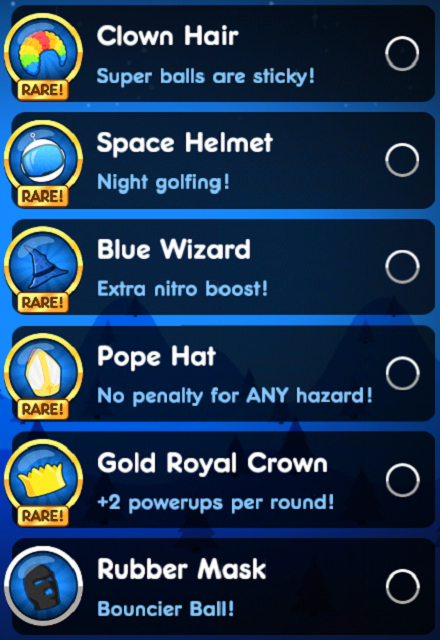
Final verdict: Cosmetics
In conclusion, cosmetics would be a good inclusion if handled well. A selection of subtle cosmetic character items which do not interfere with the gameplay, including small hats, glasses, eyepatch, moustache etc. The character's base appearance wouldn't drastically change e.g. a skull or watermelon skin, as I think that would be too far in this case.
Custom character colours and even new faces could be made available if desired, whilst some cosmetics would be unlocked by completing certain tasks, such as a glowing golden character for getting a gold medal on each hole.
Aside from character cosmetics, ball trails would be a definite inclusion as a fun and less intrusive customisation option.
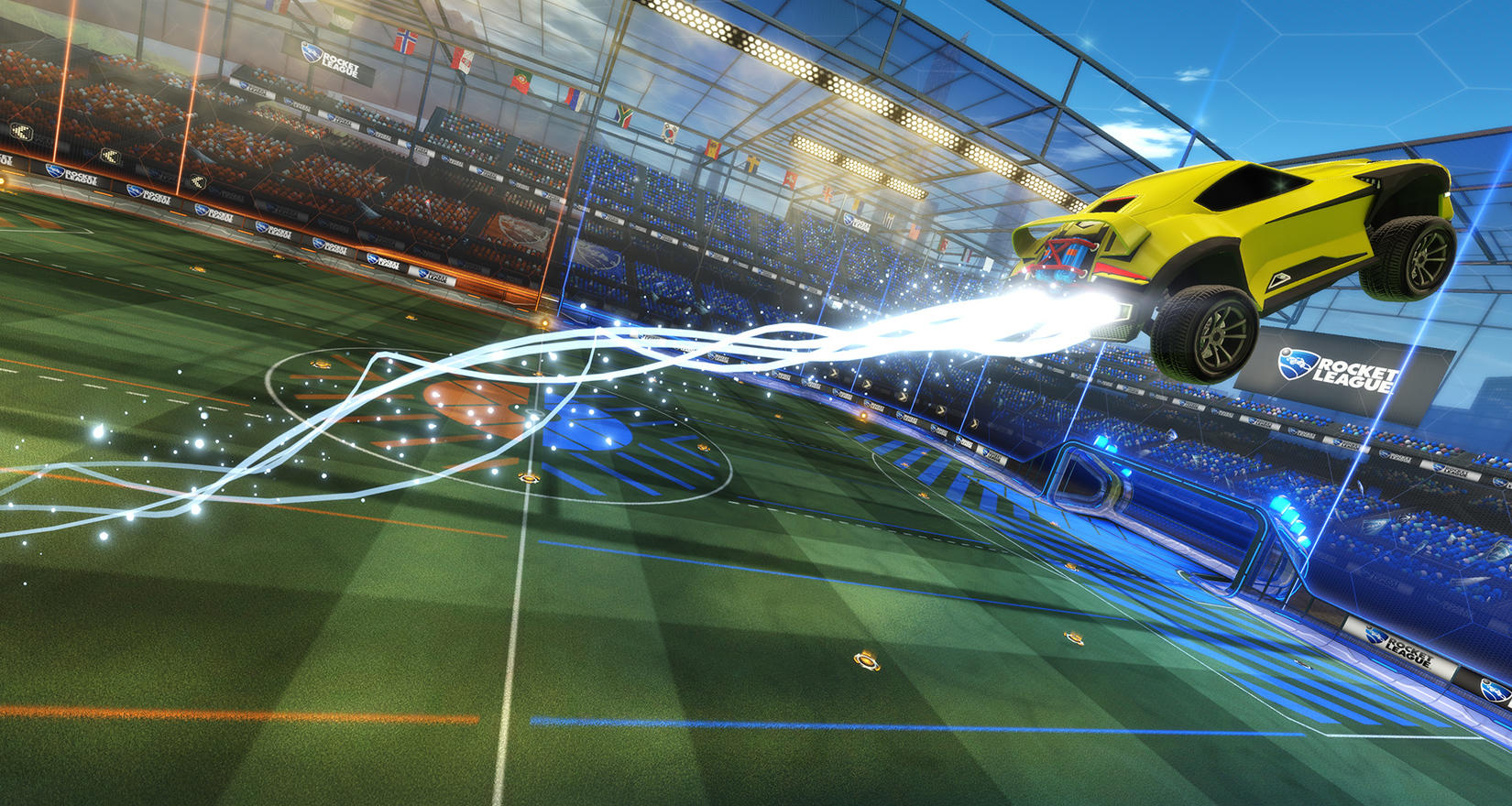
Summary of the F2P model
- An appropriate, standardised in-game currency in the form of Coins.
- Coin packs will be purchasable from the store.
- Power-ups will be incorporated and unlocked with coins.
- Mulligan (shot retake) can be used once on each hole for a small amount of coins.
- Play mode is the standard level-by-level game mode.
- Medals offer a visual representation of performance to prolong completion of each hole.
- Coin challenges within each hole to further increase level replayability and offer more variety.
- Additional content: Later courses will be unlockable via the in-game store with coins.
- Tournament mode: 18-hole courses played in succession for the game's core skill-testing mode. In this mode courses would be playable once a day in an attempt to increase player retention through habituation, as well as slow game completion.
- Daily challenges: Scenarios that reward coins to incentivise daily play.
- Challenge mode will archive all previous challenges for players to work through at their own pace (without the timed coin reward).
- High scores / Leaderboards to increase player retention and engagement.
- The Clubhouse acts as the game's visual menu. It is home to miscellaneous sections such as the store and social features.
- The Phone would allow players to recruit friends for referral rewards. Friend scores would then be shown in-game to provide friendly competition.
- The TV would offer players opt-in video ads.
- Adverts would be video ads supplemented by banner ads shown at the end of holes on the scoreboard to tie them more into the world.
- Opt-in ads would offer large coin rewards.
- Cosmetics will be subtle player customisation options that don't negatively impact gameplay, as well as other unlockables such as ball trails and special rewards for completing difficult tasks.
Conclusion
Hopefully I have presented some interesting design solutions for converting Golf & Goblins to a F2P model. I understand how integral it is to design around F2P from the very beginning of the development process and appreciate when a F2P model makes sense within the game context.
Admittedly, I am not an expert on these business models, so welcome critique of this proposal, with special regards to projected revenue of the methods chosen. Similarly, I'd be interested in receiving feedback on ways these ideas could be refined or improved in terms of design integration and gameplay experience.
I believe F2P business models can be fun and fair when done right. Personally, I favour less obtrusive measures and strategies. Ideally, I wouldn't have to implement time-limiting systems as I want players to play for as long as they desire, although I am keenly aware of the effectiveness of the system in the right scenario.
In general, my preference would be to cater more to the innate joy of completing tasks with interesting daily challenges to increase player engagement. I would want the entire base game to be playable for free, as long as players put the time in instead of paying to skip a somewhat necessary grind. I welcome a diverse monetisation approach which gives players choice on how they spend their time or money, while maximising profit potential.
References
- App sales data, Think Gaming
- The cost and reward of making a hit iOS game, Darrell Etherington, TechCrunch
- How Angry Birds 2 multiplied revenues in a year, Michael Katkoff, former SVP of Games at Rovio, DeconstructorOfFun
- Paid vs. free-to-play: Advice from notable mobile studios, Gamasutra article
- Understanding energy systems, Ed Biden
- Angry Birds 2 will save Rovio through new business model, Sune Thorsen, Nordic Game Bits
- How Rovio made Angry Birds a winner, Wired.co.uk
- How Rovio makes money, Business Insider AU
- The data behind customer acquisition and retention for F2P mobile games, Alex Walz, Apptentive
- The design of free-to-play games, Pascal Luban, Gamasutra article
- Case study of Rovio: using social media as a catapult to success, Marco Moeschter, Smart Brain Academy
- How games make money: an interview with Noodlecake Studios, Ryan Holowaty, Noodlecake Studios, Android Authority
- Ad monetization design patterns in F2P games, Eric Benjamin Seufert, Mobile Dev Memo
- The state of in-game advertising, H.B. Duran, AListDaily
Get Golf & Goblins
Golf & Goblins
A Platforming Golf Game.
| Status | Prototype |
| Author | Puchalla |
| Genre | Platformer |
| Tags | 2D, Golf, Puzzle-Platformer |
More posts
- Golf & Goblins Post-MortemOct 03, 2017
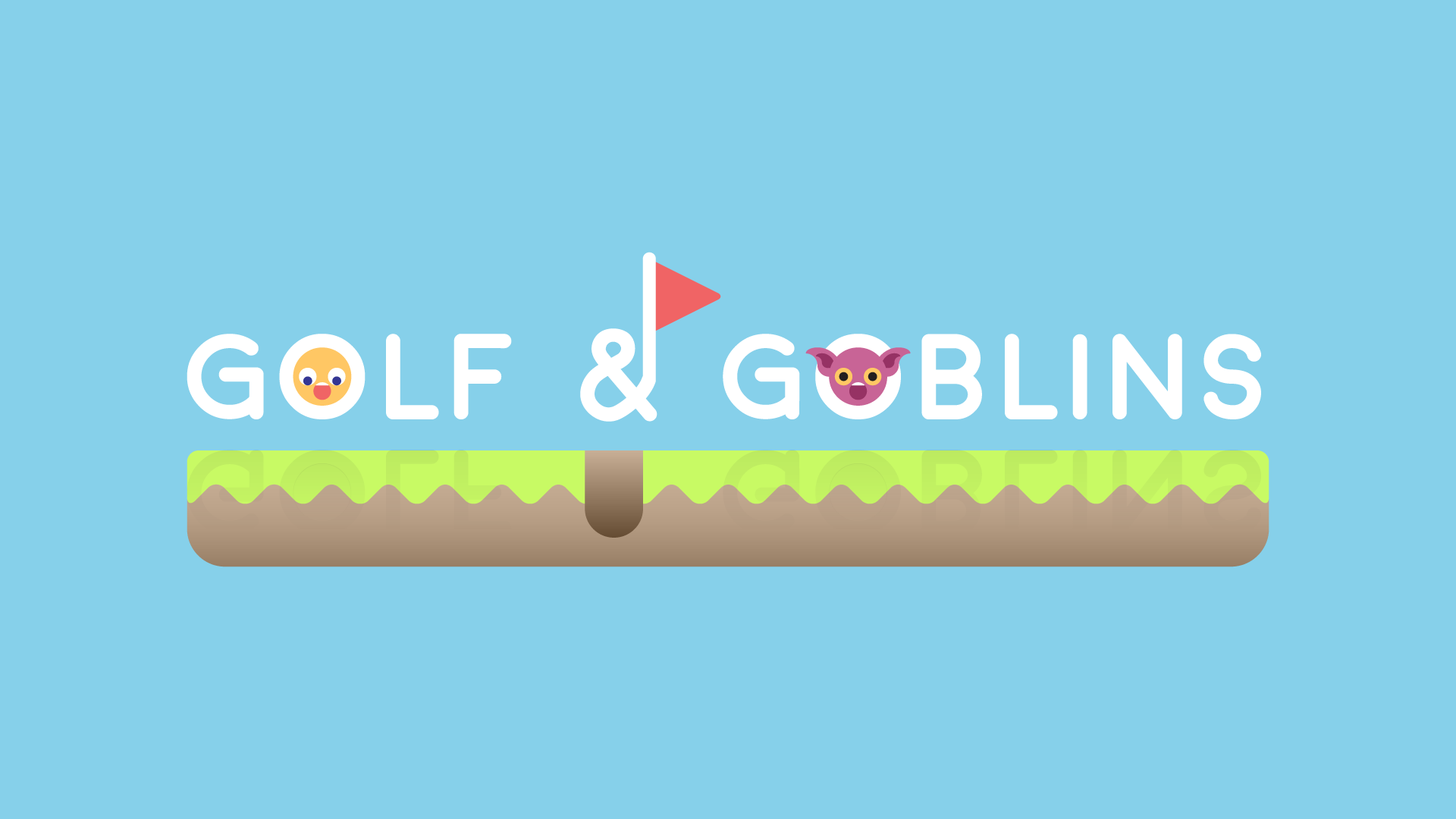
Leave a comment
Log in with itch.io to leave a comment.